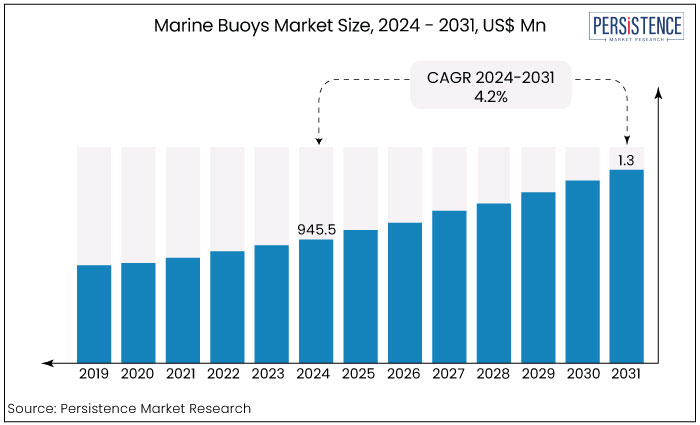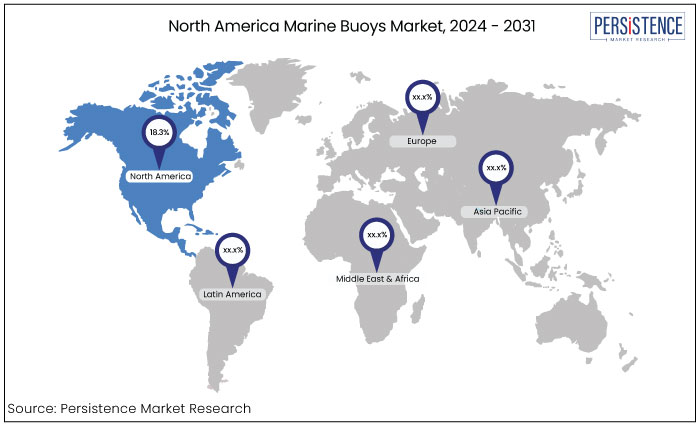Industry: Industrial Automation
Published Date: June-2024
Format: PPT*, PDF, EXCEL
Delivery Timelines: Contact Sales
Number of Pages: 169
Report ID: PMRREP32280
The global market for marine buoys is projected to increase from US$945.5 Mn in 2024 to US$1.3 Bn by the end of 2031. The market is anticipated to secure a CAGR of 4.2% during the forecast period from 2024 to 2031.

Key Highlights of the Market
|
Attributes |
Key Insights |
|
Market Size (2024E) |
US$945.5 Mn |
|
Projected Market Value (2031F) |
US$1.3 Bn |
|
Forecast Growth Rate (CAGR 2024 to 2031) |
4.2% |
|
Historical Growth Rate (CAGR 2019 to 2023) |
2.9% |
Several countries are vulnerable to territory by water routes, and governments around the world have substantially spent in their navy over the years to ensure their control in seas to some level.
Mooring Marine Buoys market are used to keep naval ships in place, and they are also sometimes employed at dockyards and in the middle of the sea for cargo ship loading and unloading.
This tendency towards ensuring national security and boosting international trade through waterways will expand the market size.
One of the significant drivers is the global increase in maritime trade activities. As international trade volumes continue to rise, the demand for marine buoys for navigation and safety purposes escalates.
Buoys play a crucial role in marking shipping lanes, navigational hazards, and channels, thereby ensuring safe passage for vessels and mitigating the risk of accidents in congested waterways.
This demand is further amplified by the expansion of port infrastructure and shipping routes globally.
Another significant driver is the increasing offshore oil and gas sector. Marine buoys are indispensable in offshore operations, where they are used to mark underwater pipelines, oil rigs, and other critical infrastructure.
As offshore exploration and production activities expand to meet global energy demands, the need for specialized buoys tailored to the requirements of these industries grows.
Ocean power technologies (OPT), a leader in marine power, data, and service solutions, has secured a significant milestone.
It is being chosen as the preferred supplier for a PowerBuoy installation integrated with Merrows, its advanced artificial intelligence (AI) maritime domain awareness system.
This opportunity, located in the Middle East, emphasizes OPT's capability to deliver immediate solutions tailored for hot climates.
The global marine buoys market expanded at a CAGR of around 2.9% between 2018 and 2023. Increasing interest in activities such as sailing, water sports and fishing trips, as well as investments in ports and beachfront property increase the market.
It is estimated to continue to grow in popularity as a mandatory installation for safe water marking and other applications.
Buoys were generally composed of iron, however plastic materials like as polyethylene are now available. They are utilised in applications like as boat mooring, marine navigation, weather observation, and nautical communications.
Many marine buoys, such as drifting buoys, are intended to float on the surface of a water bodies or to be sustained below the water's surface to indicate a position.
Polyethylene marine buoys are durable, easy to handle, self-fandering, and require little maintenance. The numerous applications of maritime buoys suggest the market's potential growth path in the forecast period.
Trade relations between developing and developed countries, as well as increases in industrialization and consumption, are promoting international trade, which is projected to generate lucrative prospects for mooring buoy makers in the upcoming years.
Several developed countries are expanding their investment in seaports to improve trade via seaways, which is also a key driving factor for the targeted market growth. The market is projected to expand at a 4.2% CAGR through 2031.
Rising Investments in Offshore Wind Power
Various governments throughout the world are always striving to meet green energy targets, which has spurred the rise of floating offshore wind generation.
Mooring buoys market growth can be attributed to the increase in floating offshore wind power, since they are installed alongside offshore wind farms to ensure safety and operating standards.
Different countries are establishing offshore wind targets for the coming years. For instance,
Rising Usage of Marine Buoys for Data Gathering & Monitoring Purposes
Data buoys are becoming increasingly important for weather forecasting and data monitoring. They are becoming important in these applications as digital technologies become widely used around the world.
Marine buoys are used to acquire and monitor data for controlling and predictive analyses in applications such as hurricane or cyclone forecasting, satellite monitoring, seasonal forecasting, maritime security, and ocean navigational aids.
The critical application of marine buoys for weather forecasting and maritime monitoring will drive market expansion in the next years.
Ongoing Operational and Maintenance Expenses Beyond Initial Costs
Ongoing operational and maintenance expenses can be substantial beyond initial costs. This includes regular inspection, cleaning, repair, and replacement of buoys.
It is particularly in harsh marine environments where exposure to saltwater, marine growth, and weather conditions can accelerate wear and damage.
Marine buoys are exposed to harsh marine environments characterized by saltwater corrosion, biofouling from marine organisms, and damage from weather events.
Addressing these challenges requires specialized equipment, trained personnel, and sometimes specialized vessels for maintenance operations. The complexity of maintenance procedures and the associated costs can be deterrents for buoy operators.
Expansion in Offshore Renewable Energy
With the global push toward renewable energy sources like offshore wind farms, there is a significant opportunity for buoys designed to support these installations.
Buoys are crucial for marking turbine locations, anchoring points, and cable routes and for environmental monitoring.
Companies can focus on developing specialized buoys tailored to the needs of offshore renewable energy projects. Offshore wind farms require extensive infrastructure including turbines, subsea cables, and support structures.
Marine buoys play a crucial role in marking these installations, delineating safe navigation routes for vessels, and ensuring overall safety in the vicinity of wind farms.
This demand for navigation buoys increases proportionally with the expansion of offshore renewable energy projects.
Continuous Growth of Global Maritime Trade
The continuous growth of global maritime trade drives the demand for buoys used to mark shipping lanes, navigational hazards, and channels.
Companies can capitalize on this demand by offering reliable and compliant buoy solutions that enhance maritime safety and efficiency.
As maritime trade volumes increase, the need for buoys to mark shipping lanes, navigational hazards, channels, and ports grows proportionally.
Buoys play a critical role in ensuring safe navigation for vessels, reducing the risk of accidents, and optimizing traffic flow in busy waterways.
Market players can capitalize on this demand by offering robust, compliant, and reliable buoy solutions that enhance maritime safety and efficiency.
Mooring Buoys Holds a significant Share in the Marine Buoys Market
|
Category |
Value Share in 2023 |
|
Mooring Buoys |
27.0% |
The study projects that by product type, the mooring buoys type is estimated to hold the value share by 27.0 % in 2023. Mooring buoy demand is also boosted by technological advancement and product innovation.
Additionally, the growing amount of shipments across different locations, as well as increased trade via the sea route, are important driving factor boosting the demand for mooring buoys market.
In offshore industries such as oil and gas, renewable energy, and aquaculture, mooring buoys are crucial for securing floating structures such as oil rigs, floating wind turbines, and fish farms.
These buoys withstand harsh marine conditions and facilitate safe operations in remote offshore locations.
Mooring buoys are available in various sizes, configurations, and materials to suit specific applications and environmental conditions.
Manufacturers offer customizable solutions that meet the unique requirements of different sectors, enhancing their versatility and market appeal.
North America’s Position Strengthens as Governments Prioritize Maritime Security
|
Region |
Value Share in 2023 |
|
North America |
18.3% |
North America is expected to hold the largest portion of the market share due to port infrastructure expansion and development plans that generate prospects for product manufacturers.
Key mooring buoy manufacturers offer an innovative range of products with technical improvement, which is expected to drive demand even higher.
North America is thus expected to account for 18.3% of the overall market in 2033. The regional governments are investing significantly on strengthening the maritime security, and naval forces.
The manufacturers dealing in marine buoys market are providing customized solutions for maritime security applications. Increase in defence expenditure is expected to have medium to high impact on the market in the US.
East Asia to Exhibit Significant Growth in Maritime Trade Volumes
|
Country |
CAGR through 2031 |
|
China |
6.2% |
The countries like China, Japan, South Korea, and Taiwan, is experiencing significant growth in maritime trade volumes.
The region's strategic location along leading shipping routes, coupled with its expanding ports and logistics infrastructure, drives the demand for marine buoys.
Buoys are essential for marking shipping lanes, navigational hazards, and port entrances, ensuring safe and efficient maritime transportation.
China expanded at a CAGR of 6.2% from 2024 to 2031. In China, marine buoys are used in various application such as fishing industry, seaborne import export of goods, navigation of cargo and commercial ships, defence and maritime security and many more applications.
The mandatory use of marine buoys in many of these applications and simultaneous growth of these industries is anticipated to create positive outlook for market in the years to come in China.

The market is highly fragmented at both the global and regional levels. The top firms control almost one-fourth of the global market.
Fugro N.V., AXYS Technologies Inc., James and Fisher PLC, and Marine Instruments S.A. are among the key players in the market.
Market participants are active in various maritime initiatives that seek installation of buoys, promotion of sustainable manufacturing, investments in research and development.
A few other strategies adopted by the key players in the market are partnerships, acquisition activities and product innovation to acquire a competitive advantage in this field.
2021
The SWP secured $47,786.80 in grant funding from the Great Lakes Observing System (GLOS) to acquire these new, cutting-edge buoys-and the SWP persists in their annual deployment, maintenance, and retrieval.
|
Attributes |
Details |
|
Forecast Period |
2024 to 2031 |
|
Historical Data Available for |
2019 to 2023 |
|
Market Analysis |
US$ Billion for Value |
|
Key Regions Covered |
|
|
Key Countries Covered |
|
|
Key Market Segments Covered |
|
|
Key Companies Profiled |
|
|
Report Coverage |
|
|
Customization & Pricing |
Available upon request |
By Product
By Material
By Region
To know more about delivery timeline for this report Contact Sales

Rising usage of marine buoys in data gathering & monitoring purposes is a key factor driving the market growth.
A few of the leading players in the market are James Fisher and Sons plc, Marine Instruments S.A., and Wealth Marine Pte Ltd.
Mooring buoys hold a significant share in the market.
Expansion in offshore renewable energy is a key opportunity in the market.
North America is expected to hold the largest portion of the market share.